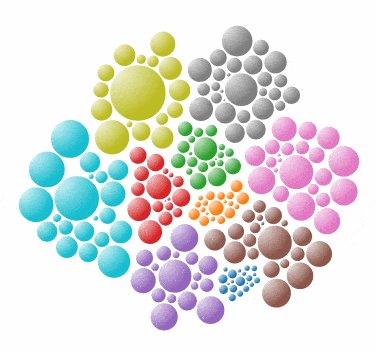在这个D3图表中,圆圈被填充了径向渐变,并且使用更改透明度来实现淡入淡出效果:


var width = 400,
height = 400,
padding = 1.5, // separation between same-color nodes
clusterPadding = 6, // separation between different-color nodes
maxRadius = 12;
var n = 200, // total number of nodes
m = 10; // number of distinct clusters
var color = d3.scale.category10()
.domain(d3.range(m));
// The largest node for each cluster.
var clusters = new Array(m);
var nodes = d3.range(n).map(function() {
var i = Math.floor(Math.random() * m),
r = Math.sqrt((i + 1) / m * -Math.log(Math.random())) * maxRadius,
d = {cluster: i, radius: r};
if (!clusters[i] || (r > clusters[i].radius)) clusters[i] = d;
return d;
});
// Use the pack layout to initialize node positions.
d3.layout.pack()
.sort(null)
.size([width, height])
.children(function(d) { return d.values; })
.value(function(d) { return d.radius * d.radius; })
.nodes({values: d3.nest()
.key(function(d) { return d.cluster; })
.entries(nodes)
});
var force = d3.layout.force()
.nodes(nodes)
.size([width, height])
.gravity(.02)
.charge(0)
.on("tick", tick)
.start();
var svg = d3.select("body").append("svg")
.attr("width", width)
.attr("height", height);
var grads = svg.append("defs").selectAll("radialGradient")
.data(nodes)
.enter()
.append("radialGradient")
.attr("gradientUnits", "objectBoundingBox")
.attr("cx", 0)
.attr("cy", 0)
.attr("r", "100%")
.attr("id", function(d, i) { return "grad" + i; });
grads.append("stop")
.attr("offset", "0%")
.style("stop-color", "white");
grads.append("stop")
.attr("offset", "100%")
.style("stop-color", function(d) { return color(d.cluster); });
var node = svg.selectAll("circle")
.data(nodes)
.enter()
.append("circle")
.style("fill", function(d, i) {
return "url(#grad" + i + ")";
})
// .style("fill", function(d) { return color(d.cluster); })
.call(force.drag)
.on("mouseover", fade(.1))
.on("mouseout", fade(1));
node.transition()
.duration(750)
.delay(function(d, i) { return i * 5; })
.attrTween("r", function(d) {
var i = d3.interpolate(0, d.radius);
return function(t) { return d.radius = i(t); };
});
function fade(opacity) {
return function(d) {
node.transition().duration(1000)
.style("fill-opacity", function(o) {
return isSameCluster(d, o) ? 1 : opacity;
})
.style("stroke-opacity", function(o) {
return isSameCluster(d, o) ? 1 : opacity;
});
};
};
function isSameCluster(a, b) {
return a.cluster == b.cluster;
};
function tick(e) {
node
.each(cluster(10 * e.alpha * e.alpha))
.each(collide(.5))
.attr("cx", function(d) { return d.x; })
.attr("cy", function(d) { return d.y; });
}
// Move d to be adjacent to the cluster node.
function cluster(alpha) {
return function(d) {
var cluster = clusters[d.cluster];
if (cluster === d) return;
var x = d.x - cluster.x,
y = d.y - cluster.y,
l = Math.sqrt(x * x + y * y),
r = d.radius + cluster.radius;
if (l != r) {
l = (l - r) / l * alpha;
d.x -= x *= l;
d.y -= y *= l;
cluster.x += x;
cluster.y += y;
}
};
}
// Resolves collisions between d and all other circles.
function collide(alpha) {
var quadtree = d3.geom.quadtree(nodes);
return function(d) {
var r = d.radius + maxRadius + Math.max(padding, clusterPadding),
nx1 = d.x - r,
nx2 = d.x + r,
ny1 = d.y - r,
ny2 = d.y + r;
quadtree.visit(function(quad, x1, y1, x2, y2) {
if (quad.point && (quad.point !== d)) {
var x = d.x - quad.point.x,
y = d.y - quad.point.y,
l = Math.sqrt(x * x + y * y),
r = d.radius + quad.point.radius +
(d.cluster === quad.point.cluster ? padding : clusterPadding);
if (l < r) {
l = (l - r) / l * alpha;
d.x -= x *= l;
d.y -= y *= l;
quad.point.x += x;
quad.point.y += y;
}
}
return x1 > nx2 || x2 < nx1 || y1 > ny2 || y2 < ny1;
});
};
}<script src="https://cdnjs.cloudflare.com/ajax/libs/d3/3.4.11/d3.min.js"></script>如何使用颜色来实现淡入淡出,而不是透明度?例如,假设我们希望使所有圆形在“淡出”状态下变为灰色,并在它们的“正常状态”下恢复它们的原始颜色?由于fill是一个对<radialGradient>元素的URL引用,因此无法仅将fill属性作为颜色值进行过渡。